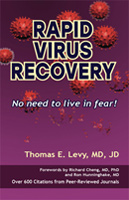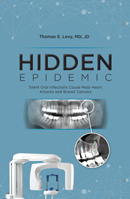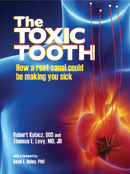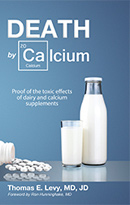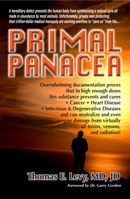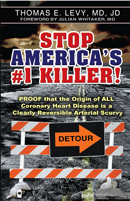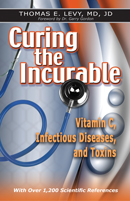Persistent Spike Protein Syndrome: Rapid Resolution with Ultraviolet Blood Irradiation
09/27/2023 by Dr. Thomas LevyReport by Fabrice Leu, ND and Thomas E. Levy, MD, JD
OMNS (September 27, 2023) This article will outline what appears to be a highly successful, readily accessible, and inexpensive therapy for dealing with the Persistent Spike Protein Syndrome, commonly referred to as chronic COVID or "long-haul" COVID, as applied and reported by Dr. Fabrice Leu of Switzerland. Long-term follow-up on the treated patients remains to be accumulated to determine whether the positive clinical and laboratory outcomes are temporary or permanent. Regardless, the therapy can be applied in minutes in the office setting, and even if there is a periodic resurgence/recurrence of spike protein in any of the patients it can be repeatedly addressed as needed. This therapy can offer a great deal of relief to millions of people continuing to suffer with the symptoms of persistent spike protein after their acute COVID infections and/or following one or more vaccinations. Whether the spike protein can ever be completely eradicated (versus just chronically suppressed) remains an issue of great concern to clinicians and their patients.
Research is now showing that the spike protein can become effectively "embedded" into the genome. [1,2] In the blood of many vaccinated persons the spike protein has already been documented to persist as long as six months. [3]
Unfortunately, the disappearance of the spike protein from the circulation does not necessarily mean that it is completely gone from the body.
UV Irradiation-A Brief History
Niels Finsen was a Danish physician who received the 1903 Nobel Prize for Physiology or Medicine for his pioneering work in the treatment of skin diseases with various applications of light (phototherapy). After initially studying the effects of sunlight on insects and animals, he turned his attention to the effects of ultraviolet (UV) light. A colleague of his had a skin condition known as lupus vulgaris (due to the same bacterium causing pulmonary tuberculosis) that was not responding to any of the traditional treatments of that time. Finsen found that UV irradiation of the affected skin areas quickly resulted in significant healing. While the discovery of antibiotic therapy quickly pushed the benefits of UV irradiation into the background, the work of Finsen largely began the research into the role that UV irradiation could play in sterilization techniques. The ability of UV light to inactivate or kill pathogens is now well-established, including for air disinfection. [4-7] The COVID pathogen has also been proven to be easily inactivated by UV irradiation. [8]
Clinically, UV irradiation of the blood has already been proven to rapidly resolve various infectious diseases. In a series of 47 patients with early to moderately advanced spinal type polio infections, UV blood irradiation was shown to cure all of them, and as a monotherapy.
Many different infections and medical conditions have been similarly been cured or greatly improved with this therapy, including acute viral hepatitis and advanced sepsis. [9,10]
D-Dimer and Persistent Spike Protein
The persistent spike protein seen in chronic COVID infection and/or following COVID vaccinations is reliably connected to elevated D-Dimer levels in the blood. D-Dimer is a product resulting from the ongoing breakdown of blood clots formed in the body. As such, elevated D-Dimer levels indicate that excess blood clotting is taking place, which is resulting in the excess presence of the clot breakdown products. [11] While a normal D-Dimer level does not completely rule out the presence of spike protein in a COVID patient or a vaccinated patient, its new presence is a clear indicator that there is a clot-promoting spike protein presence in the body, particularly in the circulating blood. Autopsy reports have shown that 80 to 100% of COVID patients have microthrombi (small blood clots) throughout their bodies. [12] In COVID patients, D-Dimer levels are nearly always elevated, and the highest levels are predictive of the poorest outcomes. [13,14] One prospective study demonstrated D-Dimer elevations in all of 137 consecutive COVID patients, and the severity of the D-Dimer elevations correlated directly with the clinical severity of the infection. [15] Once the acute COVID clinical course has resolved, continued spike protein presence has been documented to oftentimes persist for months. [16]
Spike protein has been shown to directly result in increased blood clot formation throughout the body. [17,18] In fact, good control and/or eradication of persistent spike protein cannot be claimed as long as D-Dimer levels remain elevated.
Since the persistence of an elevated D-Dimer indicates an abnormal amount of ongoing blood clot formation and dissolution, it is directly correlated with an increased mortality. This mortality increase is seen whether the elevated D-Dimer is due to a thrombosis-inducing medical condition or to persistent spike protein from COVID or vaccination. [19-21] Even though blood testing for spike protein is not yet readily available, the D-Dimer level is readily available, and it can be relied upon to effectively track the presence and degree of spike protein in the blood. Because of this, bringing an elevated D-Dimer level back into the normal range is strong evidence that the circulating spike protein has been eliminated or at least significantly suppressed. An analysis of persistent spike protein pathology and its treatment with bio-oxidative therapies has previously been published. [22]
Continuing research on COVID, vaccination status, and the Persistent Spike Protein Syndrome is now demonstrating that many, possibly a majority, of the sickest chronic COVID patients also received vaccinations. This should not be surprising, since the culprit agent in those ill individuals is the spike protein, and the purported mechanism of the shot is to disseminate mRNA-generated spike protein throughout the body in order to stimulate an immune response to the pathogen containing the spike protein.
Regardless of any generated immune response, the spike protein has its own well-documented toxicity, and continued spike protein production long after such an initial response to an mRNA vaccine is resulting in a wide range of chronic diseases and medical conditions. Spike protein toxicity is well-documented now in both human and animal studies.
Even fragments of the spike protein have been shown to be toxic and highly pathogenic. [23-25]
Of note, the toxicity and pathogenicity of the SARS-CoV coronavirus-related spike protein were documented long before the COVID pandemic. [26,27] In an animal study, a vaccine expressing SARS-CoV-related spike protein not only was unable to protect against the targeted pathogen, it also resulted in a strong inflammatory response with necrosis seen in the liver. In contrast, animals just exposed to the pathogen but remaining unvaccinated showed no clinical symptoms, further bringing into question the actual physiological role being played by the vaccine. [28]
Any shots before or after a bout of COVID promote higher spike protein levels, and those elevations are often sustained. Furthermore, the high spike protein levels often seen in post-vaccination individuals can enter an indefinite period of continued spike protein production in the cells that assimilated the mRNA from the injection. [29,30] One study showed that fully 12% of 720 subjects receiving a spike protein-producing vaccine promptly elevated their D-Dimer levels. [31] Inducing an abnormal clotting status in any patient at any time is never desirable and should not be part of any "normal" vaccination response.
UV Blood Irradiation and COVID-Related Elevated D-Dimer levels
Patients with the symptoms of chronic COVID and having elevated D-Dimer levels were treated with a protocol of UV blood irradiation. These chronic COVID patients, clinically felt to have the persistent presence of the spike protein in their blood and elsewhere, had any of the multiple symptoms commonly reported now, including cognitive and mental impairment, pain in the chest, joints, and muscles, loss or alteration of smell and taste, cough, headache, and various gastrointestinal problems. [32]
A Kastner device for UV blood irradiation was utilized for the treatment sessions. [33] This machine provides an exposure to a wavelength of 254 nm of UV-C light. Such a wavelength is especially well-absorbed by foreign proteins, which results in their denaturation (breakdown). [34,35] UV-C also disrupts both RNA and DNA, which quickly kills or inactivates the targeted pathogens. Bacteria and viruses are selectively targeted by UV irradiation, as they absorb roughly 5 times more photonic energy than the circulating red and white blood cells.
UV-C has also been documented to cause a breakdown and unfolding of the spike protein structure limiting its ability to bind the ACE2 receptor, which is the mechanism that triggers clot formation along with tissue and organ damage throughout the body. [36,37]
Patients with a D-Dimer level in excess of 500 ng/cc (or 0.5 mg/L) were included in the treatment group. The goal, in addition to symptom relief, was to bring the D-Dimer levels to less than 500, the level considered to be normal. However, it should be noted that having a D-Dimer level between 200 and 300 is more desirable than "just below" 500. A laboratory reference range, or "normal" range is based on statistical considerations that assume normalcy in most of the tested patients. Such a range fails miserably when a substantial percentage of the tested population is not normal.
UV-C irradiation, one pass: 50 cc of venous blood along with 5 cc of sodium citrate in a 60 cc syringe was given one passage through the UV-C device. After passing through the UV irradiation, the blood was returned by vein to the patient at a rate of approximately 1 cc every 3 seconds. Of note, the clear crystal tube often used for blood irradiation is not essential for effective irradiation. It was replaced with a 75 cm ASID line, a much more economic accessory. For a video demonstration of this technique: https://rumble.com/v3i5kd8-ultraviolet-blood-irradiation-1-pass.html.
UV-C irradiation, multi-pass, with oxygen added: Some of the patients also received hematogenic oxygen therapy (HOT) before the UV-C irradiation treatment of the blood. This utilizes one 60 cc syringe filled with oxygen gas connected to one end of the ASID line inside the UV-C device. The other end is connected to another 60 cc syringe with 50 cc of venous blood and 5 cc of sodium citrate. Once both ends of the ASID line are connected to their respective syringes, the contents of the oxygen syringe and the blood syringe are pushed back-and-forth in a "ping-pong" fashion through the irradiated ASID line for roughly 150 seconds. Significant foaming will be noted. The remaining non-foamed blood is then administered back to the patient intravenously. For a video demonstration of this technique: https://rumble.com/v3i59hm-hematogenic-oxydation-therapy.html. Another video more clearly demonstrates the "ping-pong" aspect of this technique: https://rumble.com/v3j379q-dubai-practitionner.html
Clinical and Laboratory Results
Although not conducted as a sizeable and tightly controlled study, the results that were seen were quite striking and indicate that substantial relief could be provided for many people. A total of 10 patients were treated with either one pass of UV-C irradiation by itself or in a multi-pass fashion as the blood specimen was passed back-and-forth through the irradiated ASID line, along with the addition of the 60 cc of oxygen gas in that closed system before being returned to the patient.
2 patients were treated with just the one pass UV-C irradiation. One was 74-years-old who received 4 UV-C one pass treatments over a 4-month period. The D-Dimer improved but did not normalize, going from 863 to 741.
The other patient was a 20-year-old male serving in the Swiss military. He had never been vaccinated. The military required COVID testing routinely every few weeks. He had developed significant pressure in his head for one to two weeks before being seen. As was required on a regular basis in the military, he had a COVID test which came back positive. He received a one pass UV-C treatment, and this was repeated 2 weeks later. His head discomfort resolved, and his D-Dimer went from slightly elevated at 519 to normal at 382. This patient alone not only demonstrates the effectiveness of UV-C blood irradiation, it also strongly implies that the circulating spike protein might be completely eliminated quite easily when such a therapy is given early-on.
8 patients were treated with the UV-C multi-pass + HOT therapy: 3 patients, ages ranging from 65 to 89 were treated. One (65-years-old) had an initial D-Dimer of 2,976. After two treatments separated by a 6-week period the D-Dimer level had dropped to 591. A 58-year-old who presented with a D-Dimer of 1,121 was given two treatments over a 1-week period. The D-Dimer level plummeted to 310. The 89-year-old had a very impressive result, with an initial D-Dimer of 1,996 dropping to 357 with 2 treatments given over a 6-week period.
5 more patients, ages ranging from 40 to 73, presented with symptoms of chronic COVID. 4 of 5 were treated with a single UV-C multi-pass + HOT therapy. No follow-up treatments were given, as these individuals felt well and did not feel the need to return for more treatment or follow-up testing. As a result no follow-up D-Dimer test could be done. The 40-year-old ended up receiving 2 treatments, and did not return after that. Initial D-Dimer levels ranged from 571 to 1,002. While yet to be precisely defined, such positive clinical responses appear to closely correlate with a declining/normalizing D-Dimer level.
Exceptional Safety
Ultraviolet blood irradiation has an impressive track record of safety over the many years of its application as a therapy. However, it is essential that the therapy be applied as recommended and not be "overdosed" as can occur with virtually any therapeutic agent or medicine. UV irradiation at the wavelength described in this article has been shown to be preferentially absorbed into the nucleic acid of the pathogens that are present while leaving the blood proteins unharmed. Because of this safety profile and pathogen-killing effectiveness, such UV irradiation is commonly used for reducing the infectivity of pathogens in plasma and other blood components harvested for subsequent administration in both animals and humans. [38,39]
Whole blood UV irradiation, along with the administration of riboflavin, has been shown to drastically reduce Plasmodium falciparum (malaria pathogen) infectivity without inducing significant hemolysis. [40] Another study also showed that UV irradiation could dramatically reduce pathogen presence without causing any significant damage to the red blood cells. [41] Even though UV blood irradiation increases the oxidative stress inside pathogens sufficiently to kill or inactivate them, it has also been shown that its effect on albumin, the main blood protein, is to increase its antioxidant capacity. [42]
Some of the concern as to the potential toxicity of UV irradiation comes from looking at the effects of UV irradiation directly on the skin rather than the blood irradiation techniques discussed in this article. Just as anyone with fair skin can get sunburned when out in the sun too long, different wavelengths of UV irradiation can cause skin damage. [43] Total amount and rate of application are always critical factors in determining how likely an agent can cause damage. Fire always burns and destroys, but the same amount of thermal energy applied slowly can nurture and heal. Proper application of the same UV irradiation known to damage the skin helps to resolve multiple dermatologic conditions. [44]
In over 1,000 patients that have been treated at the Riordan Clinic in Wichita, KS with UV blood irradiation, NO significant negative side effects were ever seen. [45]
The Riordan Clinic protocol withdraws from 60 to 300 cc of blood, adds it to a several-fold larger volume of normal saline, and ozonates it outside of the body. This blood solution is then infused over 30 to 90 minutes through a line that passes through the UV irradiation machine before being returned to the patient. An intravenous infusion of vitamin C is then administered, typically in a dose of 50 grams. Of note, investigators in Russia have reported a very infrequent occurrence of minor and transient side effects in the administration of UV blood irradiation for a wide range of medical conditions. [46] Also, there is a substantial variation among irradiation device wavelengths and the treatment protocols being utilized around the world. Nevertheless, it appears that regardless of wavelength and protocol, UV blood irradiation is an exceptionally safe and effective procedure.
Beyond its ability to kill pathogens and neutralize toxins, UV blood irradiation has been documented to result in many different positive biochemical, clinical, and metabolic changes in the treated patients. These changes have been examined in depth in review articles. [9,47]
Conclusions
The application of UV irradiation has been known to be a powerful anti-pathogen therapy for well over a century. It has been proven to be highly effective for external disinfection as well as for internal infection remediation. It remains incredibly underutilized around the world, likely due to lack of awareness along with the continuous pressure to use only costly pharmacological agents for just about everything.
Because of the now worldwide dissemination of the spike protein, D-Dimer testing needs to be done in the initial evaluation of any patient presenting with any symptom or condition.
A persistent spike protein presence can effectively masquerade as, or worsen, literally any medical condition. A positive D-Dimer test indicates the need for urgent intervention, as delay will give any circulating spike protein an increased chance of becoming embedded inside the cells and tissues, with a persistent presence that can last for the life of the patient. Spike protein is most susceptible to destruction and elimination while in the blood.
A series of UV irradiation treatments should produce even better results in patients with an elevated D-Dimer due to a persistent presence of circulating spike protein.
Hopefully, the results reported in this pilot study will help to stimulate an interest in re-documenting through new clinical research the uniqueness of UV blood irradiation as a highly effective bio-oxidative therapy for not only infections, including COVID, but nearly all other medical conditions.
The remarkable range of non-infectious medical conditions that has also been very effectively treated with UV blood irradiation, and that has already been reported in the early scientific literature before the appearance of antibiotic therapy, is covered well in several review articles. [9,10,48]
Recap
The COVID-related spike protein is currently a major cause for much of the morbidity and mortality around the world today. It can be present when an acute COVID infection does not completely resolve but instead evolves into chronicity. Vaccines, as they are designed to introduce more spike protein into the body, make it even harder to obliterate or even minimize the long-term spike protein content in the blood. It is also increasingly clear that many people can acquire a significant spike protein exposure through shedding, or casual contact with someone else harboring the spike protein. This literally puts everyone at some risk, and D-Dimer simply must become a test as routine as glucose, cholesterol, or hemoglobin.
While a wide array of therapies and supplements have been proposed to deal with the Persistent Spike Protein Syndrome, many do not result in a high degree of clinical resolution. Bio-oxidative therapies, including vitamin C, hydrogen peroxide, ultraviolet light, ozone, and hyperbaric oxygen are all very valuable in treating such patients.
This paper reports on a limited experience with UV blood irradiation therapies for the treatment of symptomatic patients with elevated D-Dimer levels. In the context of the pandemic, it appears that the unique thrombogenic nature of the spike protein reliably results in elevations of these levels. No matter how minimal a symptom might seem, an elevated D-Dimer mandates immediate and vigorous therapy. With its documented ability to denature and resolve spike protein, along with its low cost, ease of administration, and remarkable safety, UV irradiation should always be a part of the early treatment in patients with elevated D-Dimer levels when it is available.
(Dr. Fabrice Leu is a Naturopathic Practitioner with Advanced Federal Diploma of Higher Education. He is also a Trainer with Federal Diploma of Higher Education. He currently serves as President of the ASNFD, the Swiss Association of Naturopaths with Federal Diploma. See www.asnfd.org. He has had a practice of Naturopathic Medicine for 30 years now. His practice frequently applies bio-oxidative therapies like ultraviolet blood irradiation, ozone autohemotherapy, and intravenous vitamin C. He can be reached at: ecolecmn@gmail.com.
(Thomas E. Levy, MD, JD is board certified in Internal Medicine and Cardiovascular Diseases. He is also a bar-certified attorney. He can be reached at televymd@yahoo.com.
References
1. Alden M, Falla F, Yang D et al. (2022) Intracellular reverse transcription of Pfizer BioNTech COVID-19 mRNA vaccine BNT162b2 in vitro in human liver cell line. Current Issues in Molecular Biology 44:1115-1126. PMID: 35723296
2. Zhang L, Bisht P, Flamier A et al. (2023) LINE1-mediated reverse transcription and genomic integration of SARS-CoV-2 mRNA detected in virus-infected but not in viral mRNA-transfected cells. Viruses 15:629. PMID: 36992338
3. Brogna C, Cristoni S, Marino G et al. (2023) Detection of recombinant spike protein in the blood of individuals vaccinated against SARS-CoV-2: possible molecular mechanisms. Proteomics. Clinical Applications Aug 31; e2300048. Online ahead of print. PMID: 37650258
4. Reed N (2010) The history of ultraviolet germicidal irradiation for air disinfection. Public Health Reports 125:15-27. PMID: 20402193
5. Welch D, Buonanno M, Grilj V et al. (2018) Far-UVC light: a new tool to control the spread of airborne-mediated microbial diseases. Scientific Reports, 8:2752. PMID: 29426899
6. Yang J, Wu U, Tai H, Sheng W (2019) Effectiveness of an ultraviolet-C disinfection system for reduction of healthcare-associated pathogens. Journal of Microbiology, Immunology, and Infection 52:487-493. PMID: 28951015
7. Ma B, Bright K, Ikner L et al. (2023) UV inactivation of common pathogens and surrogates under 222 nm irradiation fro KrCl* excimer lamps. Photochemistry and Photobiology 99:975-982. PMID: 36129750
8. Heilingloh C, Aufderhorst U, Schipper L et al. (2020) Susceptibility of SARS-CoV-2 to UV irradiation. American Journal of Infection Control. 48:1273-1275. PMID: 32763344
9. Rowen R (1996) Ultraviolet blood irradiation therapy (photo-oxidation), the cure that time forgot. International Journal of Biosocial and Medical Research 14:115-132l https://www.drmichaelschoenwalder.com/wp-content/uploads/2020/12/Ultraviolet-Blood-Irradiation-Therapy-Photo-Oxidation-The-Cure-That-Time-Forgot.pdf
10. Hamblin M (2017) Ultraviolet blood irradiation of blood: "The cure that time forgot?" Advances in Experimental Medicine and Biology 996:295-309. PMID: 29124710
11. Weitz J, Fredenburgh J, Eikelboom J (2017) A test in context: D-Dimer. Journal of the American College of Cardiology, 70:2411-2420. PMID: 29096812
12. Kong J, Yang T, Zhang F et al. (2023) Pulmonary fat embolism: a potentially new fatal complication of SARS-CoV-2 infection. A case report. BMC Infectious Diseases 23:576. PMID: 37667198
13. Rostami M, Mansouritorghabeh H (2020) D-dimer level in COVID-19 infection: a systematic review. Expert Review of Hematology, 13:1265-1275. PMID: 32997543
14. Asakura H, Ogawa H (2021) COVID-19-associated coagulopathy and disseminated intravascular coagulation. International Journal of Hematology, 113:45-57. PMID: 33161508
15. Trofin F, Nastase E, Rosu M et al. (2023) Inflammatory response in COVID-19 depending on the severity of the disease and the vaccination status. International Journal of Molecular Sciences, 24:8550. PMID: 37239895
16. Townsend L, Fogarty H, Dyer A et al. (2021) Prolonged elevation of D-dimer levels in convalescent COVID-19 patients is independent of the acute phase response. Journal of Thrombosis and Haemostasis, 19:1064-1070. PMID: 33587810
17. Ryu J, Sozmen E, Dixit K et al. (2021) SARS-CoV-2 spike protein induces abnormal inflammatory blood clots neutralized by fibrin immunotherapy. bioRxiv Oct13, Preprint. PMID: 34671772
18. Robles J, Zamora M, Adan-Castro E et al. (2022) The spike protein of SARS-CoV-2 induces endothelial inflammation through integrin α5β1 and NF-κB signaling. The Journal of Biological Chemistry 298:101695. PMID: 35143839
19. Halaby R, Popma C, Cohen A et al. (2015) D-Dimer elevation and adverse outcomes. Journal of Thrombosis and Thrombolysis 39:55-59. PMID: 25006010
20. Kolotylo T, Moskaliuk V, Syrota B et al. (2023) Evaluation of D-Dimer level as a biomarker of disease severity and mortality in patients with COVID-19. Wiadomosci Lekarskie, 76:1636-1641. PMID: 37622508
21. Punzalan F, Aherrera J, de Paz-Silava S et al. (2023) Utility of laboratory and immune biomarkers in predicting disease progression and mortality among patients with moderate to severe COVID-19 disease at a Philippine tertiary hospital. Frontiers in Immunology 14:1123497. PMID: 36926338
22. Levy T (2023) http://orthomolecular.org/resources/omns/v19n15.shtml
23. Fernandes B, Feitosa N, Barbosa A et al. (2022) Toxicity of spike fragments SARS-CoV-2 S protein for zebrafish: a tool to study its hazardous for human health. The Science of the Total Environment 813:152345. PMID: 24942250
24. Seneff S, Kyriakopoulos A, Nigh G, McCullough P (2023) A potential role of the spike protein in neurodegenerative diseases: a narrative review. Cureus 15:e34872. PMID: 36788995
25. Cao S, Song Z, Rong J et al. (2023) Spike protein fragments promote Alzheimer's amyloidogenesis. ACS Applied Materials & Interfaces 15:40317-40329. PMID: 37585091
26. Kuba K, Imai Y, Rao S et al. (2005) A crucial role of angiotensin converting enzyme 2 (ACE2) in SARS coronavirus-induced lung injury. Nature Medicine 11:875-879. PMID: 16007097
27. Lesgards J, Cerdan D, Perronne C et al. (2023) Toxicity of SARS-CoV-2 spike protein from the virus and produced from COVID-19 mRNA or adenoviral DNA vaccines. Archives of Microbiology & Immunology 7:121-138.
28. Czub M, Weingartl H, Czub S et al. (2005) Evaluation of modified vaccinia virus Ankara based recombinant SARS vaccine in ferrets. Vaccine 23:2273-2279. PMID: 15755610
29. Cosentino M, Marino F (2022) The spike hypothesis in vaccine-induced adverse effects: questions and answers. Trends in Molecular Medicine 28:797-799. PMID: 36114089
30. Parry P, Lefringhausen A, Turni C et al. (2023) "Spikeopathy": COVID-19 spike protein is pathogenic, from both virus and vaccine mRNA. Biomedicines 11:2287. PMID: 37626783
31. Boonyawat K, Phojanasenee T, Noikongdee P et al. (2023) Incidence of anti-platelet factor4/polyanionic antibodies, thrombocytopenia, and thrombosis after COVID-19 vaccination with ChAdOx1 nCoV-19 in Thais. Thrombosis Journal 21:92. PMID: 37674185
32. Young S (2021) Long COVID or post-COVID-19 syndrome: putative pathophysiology, risk factors, and treatments. Infectious Diseases 53:737-754. PMID: 34024217
33. https://www.ozontherapie.com/products/ultraviolet/
34. Santos A, Moreirinha C, Lopes D et al. (2013) Effects of UV radiation on the lipids and proteins of bacteria studied by mid-infrared spectroscopy. Environmental Science & Technology 47:6306-6315. PMID: 23692317
35. Ruzza P, Honisch C, Hussain R, Siligardi G (2021) Free radicals and ROS induce protein denaturation by UV photostability assay. International Journal of Molecular Sciences 22:6512. PMID: 34204483
36. Mahanta N, Sharma S, Sharma L et al. (2022) Unfolding of the SARS-CoV-2 spike protein through infrared and ultraviolet-C radiation based disinfection. International Journal of Biological Macromolecules 221:71-82. PMID: 36063893
37. Strizzi S, Bernardo L, D'Ursi P et al. (2023) An innovative strategy to investigate microbial protein modifications in a reliable fast and sensitive way: a therapy oriented proof of concept based on UV-C irradiation of SARS-CoV-2 spike protein. Pharmacological Research 194:106862. PMID: 37479104
38. Seltsam A, Muller T (2011) UVC irradiation for pathogen reduction of platelet concentrates and plasma. Transfusion Medicine and Hemotherapy 38:43-54. PMID: 21779205
39. Blazquez E, Rodriguez C, Rodenas J et al. (2019) UV-C irradiation is able to inactivate pathogens found in commercially collected porcine plasma as demonstrated by swine bioassay. Veterinary Microbiology 239:108450. PMID: 31753544
40. Chaar M, Atwal S, Freimanis G et al. (2019) Inactivation of Plasmodium falciparum in whole blood by riboflavin plus irradiation. Transfusion 53:3174-3183. PMID: 23656538
41. Zhang Q, Wu C, Fan Y et al. (2020) Nucleic acid-targeted pathogen reduction technique in red blood cells by UV-generated oxygen radicals for optimizing recipient safety. Transfusion Medicine 30:51-60. PMID: 31823441
42. Yang J, Fan G, Tan F et al. (2023) The role of UVA and UVB in UV-induced skin erythema. Frontiers in Medicine 10:1163697. PMID: 37441686
43. Christensen L, Suggs A, Baron E (2017) Ultraviolet photobiology in dermatology. Advances in Experimental Medicine and Biology 996:89-104. PMID: 29124693
44. Sozarukova M, Skachko N, Chilikina P et al. (2023) Effect of low-dose line-spectrum and full-spectrum UV on major humoral components of the human blood. Molecules 28:4646. PMID: 37375200
45. From Ron Hunninghake, MD, Chief Medical Officer, Riordan Clinic, Wichita, KS
46. Marochkov A, Doronin V, Kravtsov N (1990) [Complications in ultraviolet irradiation of the blood]. Article in Russian. Anesteziologiia i Reanimatologiia 4:55-56. PMID: 2077972
47. Wu X, Hu X, Hamblin M (2016) Ultraviolet blood irradiation: is it time to remember "the cure that time forgot"? Journal of Photochemistry and Photobiology. B, Biology 157:89-96. PMID: 26894849
48. Boretti A, Banik B, Castelletto S (2021) Use of ultraviolet blood irradiation against viral infections. Clinical Reviews in Allergy & Immunology 60:259-270. PMID: 33026601
More Orthomolecular articles:
11/11/2010 | Vitamin C And The Law
02/14/2012 | Vitamin C Prevents Vaccination Side Effects; Increases Effectiveness
08/27/2013 | Vitamin C, Shingles, and Vaccination
09/03/2014 | The Clinical Impact of Vitamin C:
My Personal Experiences as a Physician
05/31/2019 | Curing Polio with Magnesium: The tip of the iceberg?
10/25/2019 | Reboot Your Gut: Optimizing Health and Preventing Infectious Disease
01/29/2020 | Vaccinations, Vitamin C, Politics, and the Law
07/18/2020 | COVID-19: How can I cure thee? Let me count the ways
08/21/2020 | Curing Viruses with Hydrogen Peroxide: Can a simple therapy stop the pandemic?
05/10/2021 | Hydrogen Peroxide Nebulization and COVID Resolution: Impressive Anecdotal Results
06/21/2021 | Resolving Long-Haul COVID and Vaccine Toxicity: Neutralizing the Spike Protein
10/18/2021 | Canceling the Spike Protein: Striking Visual Evidence
12/11/2021 | Vitamin C and Cortisol: Synergistic Infection and Toxin Defense
02/01/2022 | How COVID Helped Me Regain Good Health
05/11/2022 | The Restoration of Vitamin C Synthesis in Humans
06/01/2022 | Monkeypox Infection - To Fear or Not to Fear?
09/08/2022 | Atherosclerosis is a Non-Healing Wound
01/05/2023 | Myocarditis: Once Rare, Now Common
02/04/2023 | Resolving Colds to Advanced COVID with Methylene Blue
03/10/2023 | Resolving Persistent Spike Protein Syndrome
07/31/2023 | The Toxic Nutrient Triad
09/27/2023 | Persistent Spike Protein Syndrome: Rapid Resolution with Ultraviolet Blood Irradiation
10/12/2023 | Schizophrenia Is Chronic Encephalitis...and Niacin Cures It
11/03/2023 | Heart Failure or Therapy Failure? Toxins Cause Cardiomyopathy
12/17/2023 | Root Canals Cause Breast Cancer-Frequently
Article also available at Orthomolecular Medicine News Service
OMNS free subscription link http://orthomolecular.org/subscribe.html
OMNS archive link http://orthomolecular.org/resources/omns/index.shtml


